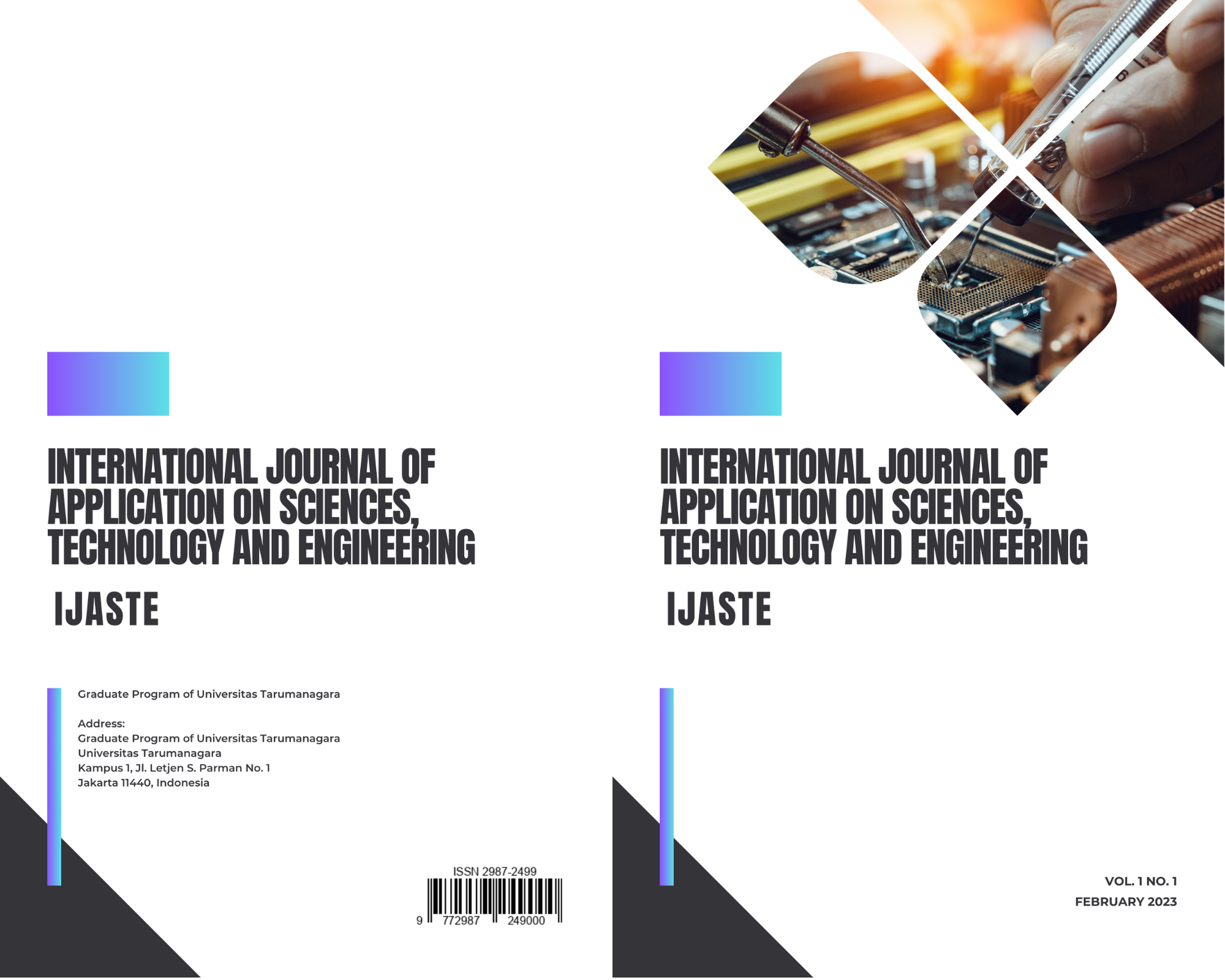The Data Analysis of Determining Potential Flood-Prone Areas in DKI Jakarta Using Classification Model Approach
Main Article Content
Abstract
The study aims to analyze the flood data in the five Jakarta areas. The focus is to determine areas that are potentially prone to flooding. Currently, there is no identification of potential flood areas in Jakarta based on actual parameters such as total rainfall, altitude, and population density. Based on this problem, a data-driven method is applied using the C4.5 algorithm. Decision trees are used to assist the classification process in determining areas that have the potential to be prone to flooding have potential flooding in the DKI Jakarta area. The 10-fold cross validation is employed along with the confusion matrix to evaluate the model between the actual and predicted results. The study shows that this algorithm can model the Jakarta potential flood-prone areas with an accuracy value of 87.20% with precision and recall values of 90.62% and 94.84%. Based on the model, the predicted flooding area can be identified utilizing the parameters.
Article Details

This work is licensed under a Creative Commons Attribution-NonCommercial-ShareAlike 4.0 International License.
References
BPS DKI Jakarta, “Jakarta Dalam Angka 2018,” DKI Jakarta, Accessed on https://jakarta.bps.go.id/publication/2018/08/16/67d90391b7996f51d1c625c4/provinsi-dki-jakarta-dalam-angka-2018.html at Sep 2019.
H. R. Fazeli, “A Study of Volunteered Geographic Information (VGI) Assessment Methods For Flood Hazard Mapping: A Review,” J. Teknol., vol. 10, pp. 127–134, 2015.
S. S. Nikam, “A Comparative Study of Classification Techniques in Data Mining Algorithms,” Int. J. Mod. Trends Eng. Res., vol. 4, no. 7, pp. 58–63, 2017.
A. Khusaeri, S. Ilham, D. Nurhasanah, D. Delpidat, and B. N. Sari, “Algoritma c4.5 untuk pemodelan daerah rawan banjir studi kasus kabupaten karawang jawa barat,” vol. 9, pp. 132–136, 2017.
E. Darwiyanto, “Aplikasi GIS Klasifikasi Tingkat Kerawanan Banjir Wilayah Kabupaten Bandung Menggunakan Metode Weighted Product,” Indones. J. Comput., vol. 2, no. 1, p. 59, 2017.
R. K. Abdullah and E. Utami, “Studi Komparasi Metode SVM dan Naive Bayes pada Data Bencana Banjir di Indonesia pembaca ataupun peneliti bisa melihat pola yang tersembunyi di.”
R. Putra, . Z., E. Madona, and A. Nasution, “Desain dan Implementasi Peringatan Dini Banjir Menggunakan Data Mining dengan Wireless Sensor Network,” J. Nas. Tek. Elektro, vol. 5, no. 2, p. 181, 2018.
T. N. Phyu, “Survey of classification techniques in data mining,” Proc. Int. MultiConference Eng. Comput. Sci., vol. 1, pp. 18–20, 2009.
M. Sadikin and F. Alfiandi, “Comparative study of classification method on customer candidate data to predict its potential risk,” Int. J. Electr. Comput. Eng., vol. 8, no. 6, pp. 4763–4771, 2018.
D. Fitrianah, N. H. Praptono, A. N. Hidayanto, and A. M. Arymurthy, “Feature Exploration for Prediction of Potential Tuna Fishing Zones,” vol. 5, no. 4, pp. 270–274, 2015.
K. Adhatrao, A. Gaykar, A. Dhawan, R. Jha, and V. Honrao, “Predicting Students’ Performance Using Id3 And C4.5 Classification Algorithms,” Int. J. Data Min. Knowl. Manag. Process, vol. 3, no. 5, pp. 39–52, 2013.
R. D. H. Devi and M. I. Devi, “Outlier detection algorithm combined with decision tree classifier for early diagnosis of breast cancer,” Int. J. Adv. Eng. Technol., vol. 7, no. 2, pp. 93–98, 2016.
S. K. Yadav, “Data Mining : A Prediction for Performance Improvement of Engineering Students using Classification,” World Comput. Sci. Inf. Technol. J. (WCSIT, vol. 2, no. 2, pp. 51–56, 2012.
W. Dai and W. Ji, “A mapreduce implementation of C4.5 decision tree algorithm,” Int. J. Database Theory Appl., vol. 7, no. 1, pp. 49–60, 2014.
S. Sathyadevan and R. R. Nair, “Comparative Analysis of Decision Tree Algorithms: ID3, C4.5 and Random Forest,” vol. 711, pp. 549–562, 2019.
Z. Masetic, A. Subasi, and J. Azemovic, “Malicious Web Sites Detection using C4.5 Decision Tree,” vol. 5, no. 1, 2016.
M. Mirqotussa’adah, B. Prasetiyo, S. Alimah, E. Sugiharti, and M. A. Muslim, “Penerapan Dizcretization dan Teknik Bagging Untuk Meningkatkan Akurasi Klasifikasi Berbasis Ensemble pada Algoritma C4.5 dalam Mendiagnosa Diabetes,” Lontar Komput. J. Ilm. Teknol. Inf., vol. 8, no. 2, p. 135, 2017.
Ihsan and R. Wajhillah, “Penerapan Algoritma C4.5 Terhadap Diagnosa Penyakit Demam Tifoid Berbasis Mobile,” J. Swabumi AMIK BSI Sukabumi, vol. III, no. 1, pp. 50–58, 2015.
E. Buulolo, N. Silalahi, Fadlina, and R. Rahim, “C4.5 Algorithm To Predict the Impact of the Earthquake,” Int. J. Eng. Res. Technol., vol. 6, no. 2, 2017.
M. T. Firmansyah and Rusito, “Implementasi Metode Decision Tree Dan Algoritma C4.5 Untuk Klasifikasi Data Nasabah Bank,” Infokam, vol. XII, pp. 1–12, 2016.
J. A. Suyatno, F. Nhita, and A. A. Rohmawati, “Rainfall forecasting in Bandung regency using C4.5 algorithm,” 2018 6th Int. Conf. Inf. Commun. Technol. ICoICT 2018, vol. 0, no. c, pp. 324–328, 2018.
D. T. Wahyuni and A. Luthfiarta, “Prediksi Hasil Pemilu Legislatif DKI Jakarta Menggunakan Naive Bayes Dengan Algoritma Genetika Sebagai Fitur Seleksi,” Jur. Tek. Inform. FIK Udinus, 2014.
Badan Meteorologi Klimatologi dan Geofisika, “Data Curah Hujan DKI Jakarta,” 2019. Accessed on https://reactora.net/data-curah-hujan-dki-jakarta/ at Sep 2019.
K. Rajesh and S. Anand, “Analysis of SEER Dataset for Breast Cancer Diagnosis using C4 . 5 Classification Algorithm,” vol. 1, no. 2, pp. 72–77, 2012.
L. S. Malang et al., “Penerapan Metode Naive Bayes dalam Pengklasifikasi Trafik Jaringan,” Smatik J., vol. Vol 06, no. January 2016, pp. 26–36, 2017.



